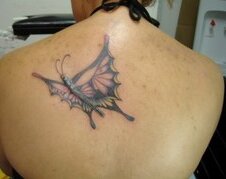Many people, especially women who have had mastectomies or other invasive surgery, are electing just to do that.
The procedure, called scar tattooing, is still relatively uncommon, but more tattoo parlors and artists around the country are taking on the challenge, with increasingly imaginative results. The process is not without risks, but those who have received the tattoos say the immeasurable boost to their self-image outweighs any health concerns they may have had.
Sasha Merritt, 38, is one of the few tattooists in the country specialize in the practice. She has run a parlor in San Francisco’s gritty Mission District for the last 10 years, but started tattooing over scars only in the last five, after a friend who had had a mastectomy approached her with the idea.

Jane Fox had her mastectomy scar incorporated into a skeletal lizard design.
(Courtesy of Jane Fox)

Tatttooist Damien Deeds created a butterfly around his customer’s keloid scar.
(Courtesy of Damien Deeds)
The procedure isn’t like getting a normal tattoo though. For starters, the new tissue can be less receptive to the ink, requiring several runs in some instances. In addition, straight lines usually become fuzzy. For this reason, artists are reluctant to do lettering on or around a scar unless the customer intends for such an effect.
On the upside, however, people electing to tattoo over a scar say it is often less painful than ordinary tattoos as the skin immediately surrounding some scars tends to lose sensation.
This type of tattooing does require some precautions. People should wait at least a year before tattooing over a scar, said Dr. Thomas Le, the director of the Facial Plastic Surgery Department at the University of Maryland Medical Center. Otherwise, they risk irritating skin tissue that is essentially still healing, he said. He also cautions that scars often change color in the first year or so and tattooing over one too soon can result in a regrettable mismatch.
Source: This article was originally written by Andrew Kersey.



I have been online looking for the location of damien deeds tatto shop! Where isit located?